FENOMENO all
Schlechtriem, Christian <Diese E-Mail-Adresse ist vor Spambots geschützt! Zur Anzeige muss JavaScript eingeschaltet sein!>; "Wanzenböck, Josef" <Diese E-Mail-Adresse ist vor Spambots geschützt! Zur Anzeige muss JavaScript eingeschaltet sein!>; Engelhard, Carsten, Jun.-Prof. Dr. <Diese E-Mail-Adresse ist vor Spambots geschützt! Zur Anzeige muss JavaScript eingeschaltet sein!>; Isabel Lopes <Diese E-Mail-Adresse ist vor Spambots geschützt! Zur Anzeige muss JavaScript eingeschaltet sein!>; Witte, Klaudia, Prof. Dr. <Diese E-Mail-Adresse ist vor Spambots geschützt! Zur Anzeige muss JavaScript eingeschaltet sein!>; Kuhnert, Klaus-Dieter, Dr. <Diese E-Mail-Adresse ist vor Spambots geschützt! Zur Anzeige muss JavaScript eingeschaltet sein!>; Lamatsch, Dunja <Diese E-Mail-Adresse ist vor Spambots geschützt! Zur Anzeige muss JavaScript eingeschaltet sein!>; Susana Loureiro <Diese E-Mail-Adresse ist vor Spambots geschützt! Zur Anzeige muss JavaScript eingeschaltet sein!>; Gethmann, Carl Friedrich Diese E-Mail-Adresse ist vor Spambots geschützt! Zur Anzeige muss JavaScript eingeschaltet sein!; Schoenherr, Holger Diese E-Mail-Adresse ist vor Spambots geschützt! Zur Anzeige muss JavaScript eingeschaltet sein!; Vogt, Roland <Diese E-Mail-Adresse ist vor Spambots geschützt! Zur Anzeige muss JavaScript eingeschaltet sein!>; Kunze, Jan <Diese E-Mail-Adresse ist vor Spambots geschützt! Zur Anzeige muss JavaScript eingeschaltet sein!>; Steinhoff, Benedikt <Diese E-Mail-Adresse ist vor Spambots geschützt! Zur Anzeige muss JavaScript eingeschaltet sein!>; Beyer-Neidhardt, Rosemarie Diese E-Mail-Adresse ist vor Spambots geschützt! Zur Anzeige muss JavaScript eingeschaltet sein!; Diese E-Mail-Adresse ist vor Spambots geschützt! Zur Anzeige muss JavaScript eingeschaltet sein!; Hartmann, Sarah Diese E-Mail-Adresse ist vor Spambots geschützt! Zur Anzeige muss JavaScript eingeschaltet sein!; Diese E-Mail-Adresse ist vor Spambots geschützt! Zur Anzeige muss JavaScript eingeschaltet sein!; Diese E-Mail-Adresse ist vor Spambots geschützt! Zur Anzeige muss JavaScript eingeschaltet sein!
Coordinator
Schoenherr, Holger Diese E-Mail-Adresse ist vor Spambots geschützt! Zur Anzeige muss JavaScript eingeschaltet sein!
Please include me and my secretary in all important correspondence (Beyer-Neidhardt, Rosemarie <Diese E-Mail-Adresse ist vor Spambots geschützt! Zur Anzeige muss JavaScript eingeschaltet sein!>
Principle investigators (essentially overlaps with WP Leaders)
Schlechtriem, Christian <Diese E-Mail-Adresse ist vor Spambots geschützt! Zur Anzeige muss JavaScript eingeschaltet sein!>; "Wanzenböck, Josef" <Diese E-Mail-Adresse ist vor Spambots geschützt! Zur Anzeige muss JavaScript eingeschaltet sein!>; Engelhard, Carsten, Jun.-Prof. Dr. <Diese E-Mail-Adresse ist vor Spambots geschützt! Zur Anzeige muss JavaScript eingeschaltet sein!>; Isabel Lopes <Diese E-Mail-Adresse ist vor Spambots geschützt! Zur Anzeige muss JavaScript eingeschaltet sein!>; Witte, Klaudia, Prof. Dr. <Diese E-Mail-Adresse ist vor Spambots geschützt! Zur Anzeige muss JavaScript eingeschaltet sein!>; Kuhnert, Klaus-Dieter, Dr. <Diese E-Mail-Adresse ist vor Spambots geschützt! Zur Anzeige muss JavaScript eingeschaltet sein!>; Lamatsch, Dunja <Diese E-Mail-Adresse ist vor Spambots geschützt! Zur Anzeige muss JavaScript eingeschaltet sein!>; Susana Loureiro <Diese E-Mail-Adresse ist vor Spambots geschützt! Zur Anzeige muss JavaScript eingeschaltet sein!>; Gethmann, Carl Friedrich Diese E-Mail-Adresse ist vor Spambots geschützt! Zur Anzeige muss JavaScript eingeschaltet sein!; Schoenherr, Holger <Diese E-Mail-Adresse ist vor Spambots geschützt! Zur Anzeige muss JavaScript eingeschaltet sein!>
Postdocs & Ph.D. students
Vogt, Roland <Diese E-Mail-Adresse ist vor Spambots geschützt! Zur Anzeige muss JavaScript eingeschaltet sein!>; Kunze, Jan <Diese E-Mail-Adresse ist vor Spambots geschützt! Zur Anzeige muss JavaScript eingeschaltet sein!>; Steinhoff, Benedikt Diese E-Mail-Adresse ist vor Spambots geschützt! Zur Anzeige muss JavaScript eingeschaltet sein!; Diese E-Mail-Adresse ist vor Spambots geschützt! Zur Anzeige muss JavaScript eingeschaltet sein! ; Hartmann, Sarah Diese E-Mail-Adresse ist vor Spambots geschützt! Zur Anzeige muss JavaScript eingeschaltet sein!; Diese E-Mail-Adresse ist vor Spambots geschützt! Zur Anzeige muss JavaScript eingeschaltet sein!; Diese E-Mail-Adresse ist vor Spambots geschützt! Zur Anzeige muss JavaScript eingeschaltet sein!
Fate and effect of waste water-borne manufactured nanomaterials in aquatic ecosystems (http://www.fenomeno-nano.de/ )
FENOMENO WORKSHOP zum Thema
Nanomaterialien in der Umwelt ‐ Neue Ansätze zur Analyse und Risikobewertung
(Nanomaterials in the Environment ‐ New Approaches to Analysis and Risk Assessment)
Mittwoch, 21.03.2018
Universität Siegen
Artur Woll Haus, Am Eichenhang 50, 57076 Siegen
8:45 - 9:15 Registrierung
Teil 1 ab 9:15 (englischsprachig)
9:15 Prof. Holger Schönherr (Siegen): Welcome & Project FENOMENO in a nutshell
9:25 M.Sc. Roland Vogt (UIBK): Environmental Partitioning of Silver Nanoparticle Contamination in Lake Mondsee
9:40 M.Sc. Richard Zeumer (Fraunhofer IME): Fate and Effect of Manufactured Nanomaterials in the Aquatic Food Chain.
9:55 M.Sc. Daria Mozhayeva (Siegen) : Advances in Nanomaterial Characterization
Using Inductively Coupled Plasma Mass Spectrometry
10:10 M.Sc. Benedikt Steinhoff (Siegen): Nanoparticles in the environment - How to find a
needle in a haystack
10:25 M.Sc. Sara Hartmann (Siegen): Biogenic effects of wastewater-borne silver and titanium dioxide nanoparticles to Daphnia magna.
10:40 Dr. Victor Galhano (Aveiro): Ecotoxicological tools to evaluate the environmental
impact of nanoparticles
10:55 Coffee break & Posters
11:25 Dr. Yvonne Kohl vom Fraunhofer IBMT (Projekt NanoUmwelt): Engineered nanomaterials in the environment: identification, quantification and analysis of human- and ecotoxicological effects
11:55 M.Sc. Irina Politowski (RWTH Aachen): CNT exposure in freshwater algae Pseudokirchneriella subcapitata and Chlamydomonas reinhardtii: bioavailability and long-term effects.
12:10 Dr. Jürgen Schnekenburger (Münster), Biomedizinisches Technologiezentrum: Digital Holographic Microscopy for in vitro testing of nanomaterial toxicity
12:40 Prof. Dr. Martin Wiemann (Münster), IBE R&D gGmbH (Projekt NanoBioDetect)
Moderne Imaging-Methoden zum Nachweis von Nanomaterialien in Gewebe
13:10 Lunch & Posters
13:45 Frau Dr. Andrea Haase (Berlin), Bundesinstitut für Risikobewertung (Projekt NanoToxClass): NanoToxClass: Establishing nanomaterial grouping strategies based on multi-omics analyses
14:15 Ende Teil 1
Teil 2 ab 14:15 (deutschsprachig)
14:15 Sebastian Kühr (Fraunhofer IME / Siegen): Ökotoxikologie & Nanomaterialien in der Umwelt
14:45 Prof. Klaudia Witte (Siegen): Wasserflöhe als Biosensoren für Nanopartikel
15:15 Univ.-Prof. Dr. phil. Dr. phil. h.c. Carl Friedrich Gethmann (Siegen): Ethische Fragen beim Herstellen und In-Verkehrbringen von Nanomaterialien. Risiko-Chancen- Abwägungen und Vorsorgeprinzip
15:45 M.Sc. Benedikt Steinhoff (Siegen): Auf der Suche nach den kleinsten Teilchen in Umweltproben mit modernsten Mikroskopen
15:55 M.Sc. Bastian Spelz (Siegen): Nanomaterialanalytik mittels plasmabasierter Techniken
16:05 M.Sc. Sara Hartmann (Siegen): Zebrafische im Dienst der Wissenschaft: Verändern Nanopartikel die Schwimmaktivität von Fischlarven?
16:15 Prof. Holger Schönherr (Siegen) - Abschließende Diskussion,
Concluding Remarks und Verabschiedung
__________________________________________________________________________________
Kontaktadresse:
Prof. Dr. Holger Schönherr
Diese E-Mail-Adresse ist vor Spambots geschützt! Zur Anzeige muss JavaScript eingeschaltet sein!
Tel. ++49 271 740 2806
Teilnehmerzahl: begrenzt, ca. 50 Personen
Anmeldung: Kostenlose Registrierung
(per E-Mail an Diese E-Mail-Adresse ist vor Spambots geschützt! Zur Anzeige muss JavaScript eingeschaltet sein!)
_________________________________________________________________________________
Prof. Dr. Carsten Engelhard, Prof. Dr. Klaudia Witte, und Prof. Dr. Holger Schönherr
Department Chemie - Biologie
____________________________________________________________________________________________________________
M36 Meeting at Fraunhofer IME, Schmallenberg, March 20th 2018
M24 Meeting at the University of Aveiro, Portugal, March 28th & 29th 2017
The M24 Project Meeting of FENOMENO took place at the Department of Biology of the University of Aveiro. In addition to the meeting, a dedicated workshop on Ethics and Risk Assessment was organized on March 30th, in which among others Dr. Bruno Gransche (FoKoS, University of Siegen) lectured on “Nano beyond risk – An introduction to applied ethics and the specific challenges of nano‐ethics”.
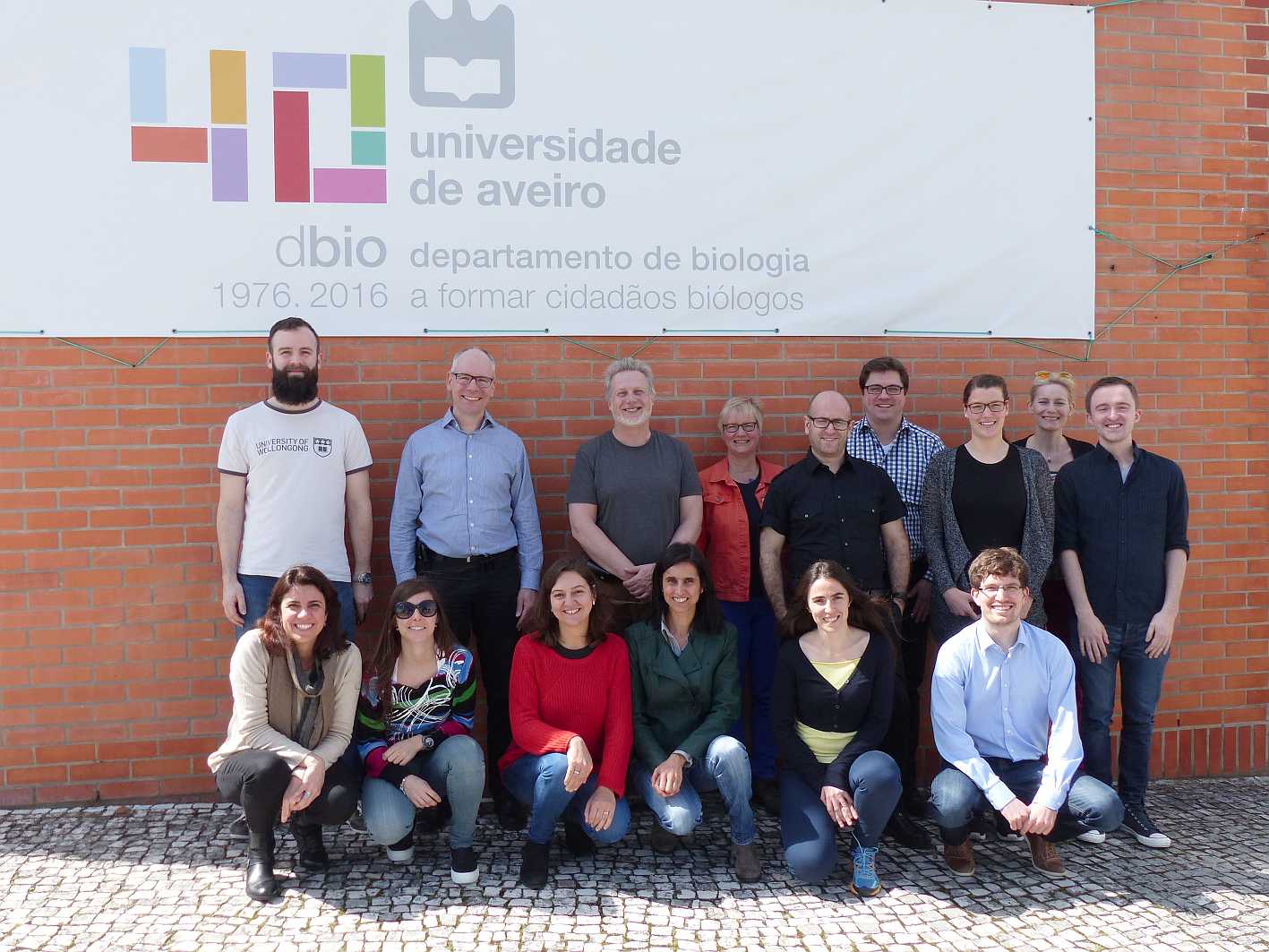
M12 Meeting at Mondsee, Austria, April 7th & 8th 2016
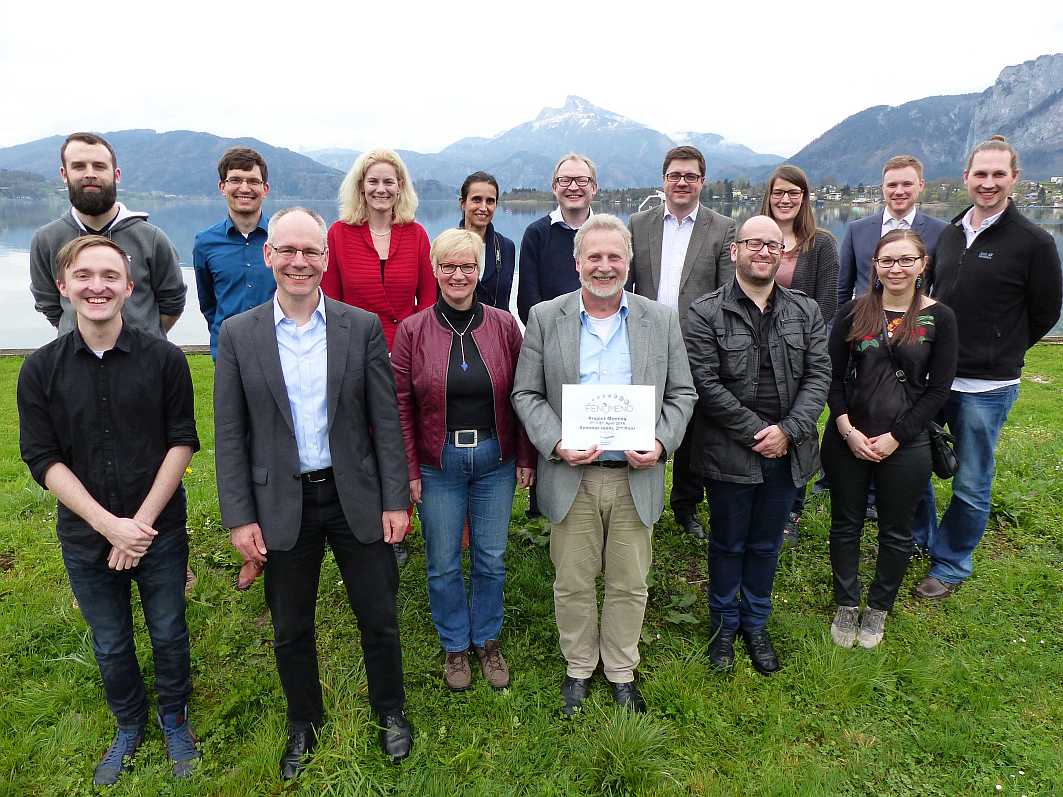
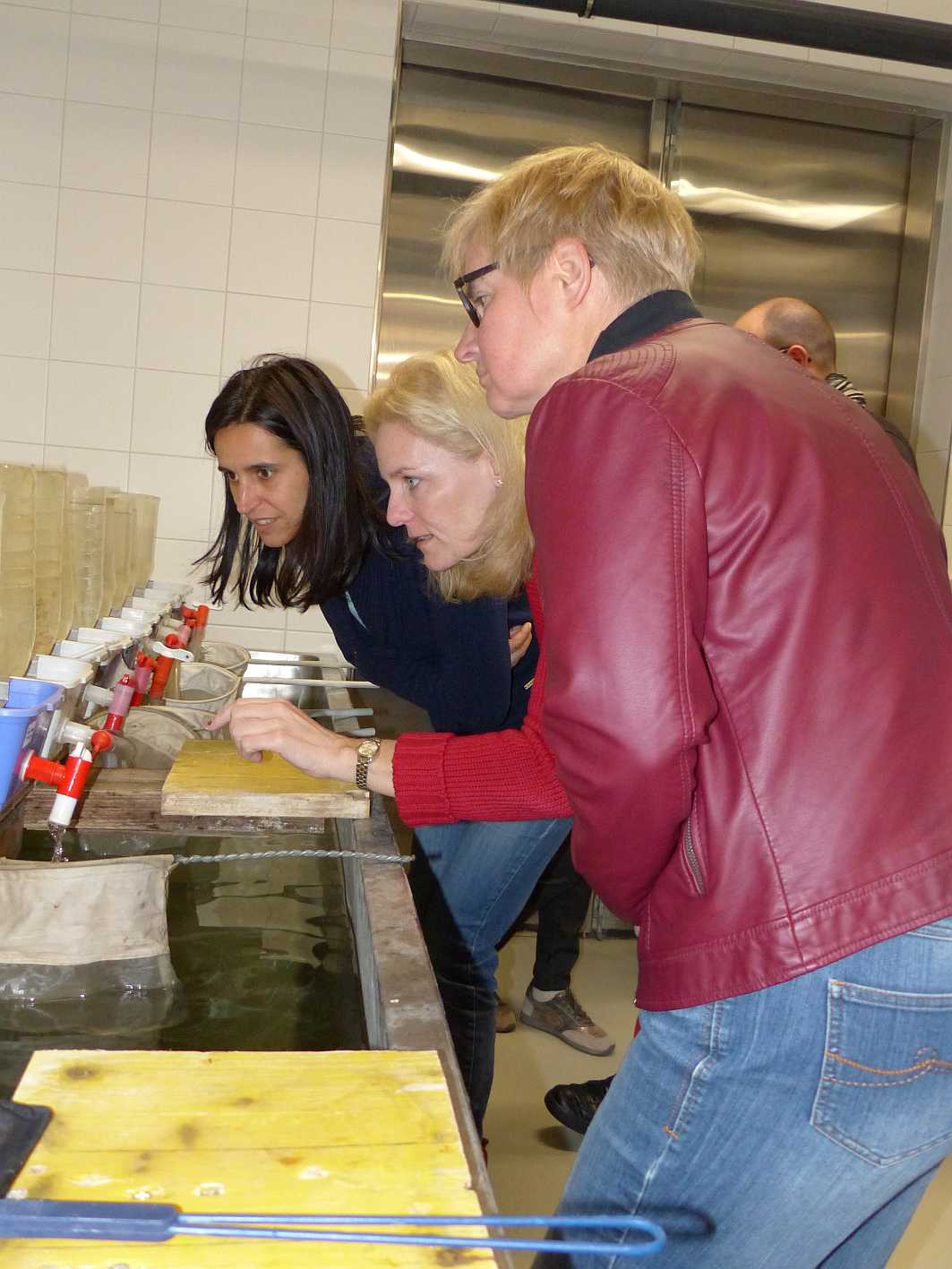
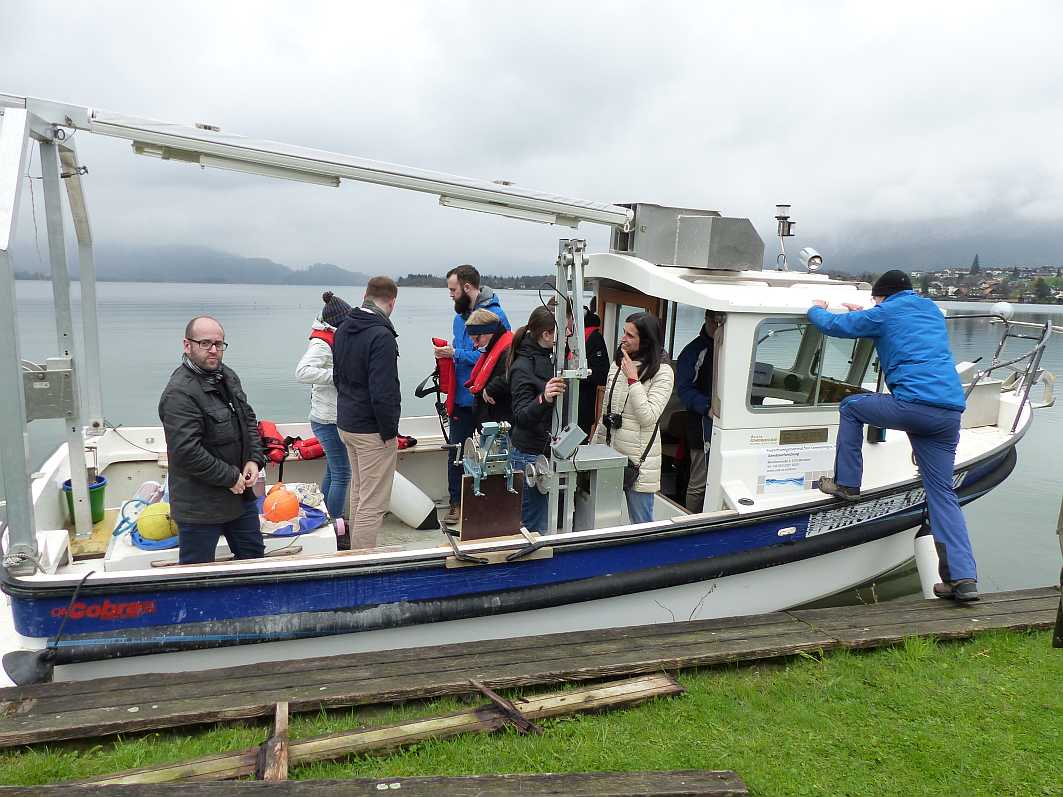
(Press release, University of Innsbruck, NANOPARTIKEL - der Mondsee als Modellökosystem, https://www.uibk.ac.at/limno/news/)
FENOMENO Kick-off Meeting in Siegen, April 29th, 2015
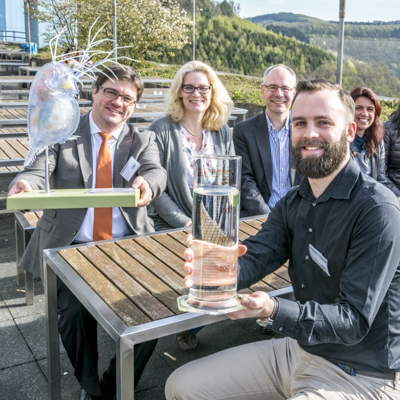
Photograph: Press Office of the University of Siegen
http://www.uni-siegen.de/presse/press_releases/635585.html
https://www.uni-siegen.de/start/news/oeffentlichkeit/635566.html

Relevance of the Problem
Manufactured nanomaterials (MNMs) altered by the treatments in waste water treatment plants (WWTPs) may pose a risk for the environment. Via transfer of post-WWTP MNMs in food webs and bioaccumulation this may lead ultimately to risks also for human health. The assessment of chronic toxicological endpoints and the bioaccumulation potential is hence an important part of the substance evaluation and requires test systems suitable for MNMs. Furthermore, such studies need to be carried out not only on pristine MNMs, but also on NPs processed by WWTP to allow for a realistic hazard and risk assessment. To evaluate existing impact of MNMs in aquatic ecosystems there is a need for fast detection methods. These methods developed and refined in FENOMENO will help to generate a more efficient system to monitor the impairment of ecological functionality by post- WWTP MNMs. If available, this will allow the validation of the risk assessment that is indispensable to understand the impact of end-of-life MNMs on the environment and to ensure a safe use of MNMs.
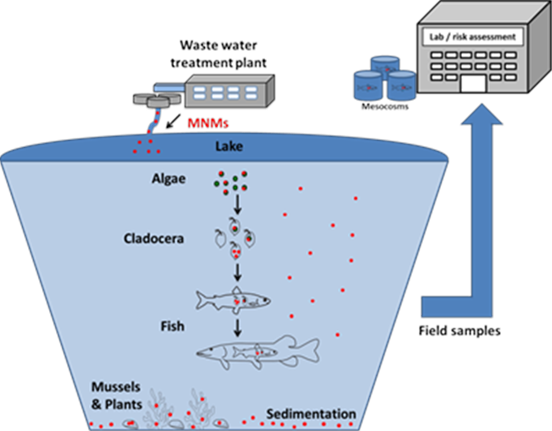
Project Focus and Targets
|
|
|
Analysis of Ag and TiO2 MNMs in model and real WWTP effluents. |
|
Development of analytical procedures for the determination and characterization of MNMs in very low environmental concentrations (fundamental for monitoring approaches, e.g. within Water Framework Directive 2000/60/EC); adaptation of the model WWTP according to OECD 303 for MNM testing, identification & validation of biomarkers to show clear response following MNMs exposure. |
|
Chronic exposure of algae, Daphnia, and fish to investigate behavioural changes and trans-generational effects, impact on growth, reproduction and survival (algae, Daphnia, fish) and impact on selected biomarkers induced by wastewater-borne MNMs (laboratory approach). |
|
Laboratory studies on transfer of MNMs in a 3 step food chain (algae, Daphnia, fish). Investigation of tissue distribution of bioaccumulated MNMs in test organisms. |
|
Monitoring of field samples (water, algae, Daphnia, fish samples etc.) collected from Lake Mondsee, Austria. |
|
Assessment of environmental effects caused by wastewater-borne MNMs in Lake Mondsee based on calibrated biomarkers and bioaccumulation in biotic components. |
|
Determination of effects of long-term exposure to MNMs in three taxonomic/functional groups as well as in long-term exposed natural aquatic populations. |
|
Compute risks quotients for single exposure to MNMs and to a mixture of MNMs (TiO2 and Ag), and apply the framework to make a retrospective risk assessment in a real MNM contamination scenario at Lake Mondsee. |
|
Determination of toxic effects of pristine and WWTP transformed MNM to three taxonomic/functional levels (considered in REACH for traditional chemicals). Computation of retrospective risk in a real MNM contaminated case study, based on lab and field data. |

Mattauch Herzog Award (2018) for Carsten Engelhard presented at the 2018 European Mass Spectrometry Conference, EMSC, Saarbrücken, Germany, March 12, 2018. (http://www.uni-siegen.de/start/news/oeffentlichkeit/810261.html)
FENOMENO WORKSHOP zum Thema
Nanomaterialien in der Umwelt ‐ Neue Ansätze zur Analyse und Risikobewertung
(Nanomaterials in the Environment ‐ New Approaches to Analysis and Risk Assessment)
Mittwoch, 21.03.2018 Universität Siegen, Artur Woll Haus, Am Eichenhang 50, 57076 Siegen
For Details: see FENOMENO Events
TV Reports
ARTE, Xenius, 14. Januar 2019, 16:45
Bayrischer Rundfunk (BR), Gut zu wissen, „Ameisenforschung – Storchenflug – Nano-Partikel“, September 29, 2018
Peer-Reviewed Publications
Mozhayeva, D.; Engelhard, C. Separation of Silver Nanoparticles with Different Coatings by Capillary Electrophoresis Coupled to ICP-MS in Single Particle Mode, Anal. Chem., 2017, 89, 9767-9774, (DOI:10.1021/acs.analchem.7b01626).
Mozhayeva D.; Strenge, I.; Engelhard, C. Implementation of Online Pre-Concentration and Microsecond Time Resolution to Capillary Electrophoresis Single Particle Inductively Coupled Plasma Mass Spectrometry (CE-SP-ICP-MS) and its Application in Silver Nanoparticle Analysis, Anal. Chem., 2017, 89, 7152-7159
(DOI: 10.1021/acs.analchem.7b01185).
Hartmann, S.; Vogt, R.; Kunze, J.; Rauschert, A.; Kuhnert, K.-D.; Wanzenböck, J.; Lamatsch, D.; Witte, K. Zebrafish larvae show negative phototaxis to near- infrared light, PloS one, 2018, 11, e0207264, (DOI: 10.1371/journal.pone.0207264).
Hartmann, S.; Louch, R.; Zeumer, R.; Mozhayeva, D.; Engelhard, C.; Schlechtriem, C.; Witte, K. (2018) Comparative multi-generation study of long-term effects of pristine and wastewater-borne silver and titanium dioxide nanoparticles on important lifecycle parameters in Daphnia magna (in Vorbereitung).
Steinhoff, B.; Vogt, R.; Spelz, B; Wanzenböck, J.; Engelhard, C.; Schönherr, H. Comprehensive Approach for the Detection of Manufactured Nanomaterials in the Aquatic Environment (in Vorbereitung).
Steinhoff, B.; Zeumer, R.; Hartmann, S.; Mozhayeva, D.; Spelz, B.; Vogt, R.; Schlechtriem, C.; Witte, K.; Engelhard, C.; Wanzenböck, J.; Schönherr, H. Recovery and Characterization of Silver Nanoparticles from Aquatic Specimens (in Vorbereitung).
Zeumer, R., Knopf, B., Meisterjahn, B., Vogt, R., Soares, A.M.V.M., Loureiro, S., Monteiro, M.S., Galhano, V., Lopes, I., Wanzenböck, I., Schlechtriem, C. (2018). Fate and effect of wastewater borne manufactured nanomaterials in the aquatic food chain. (in Vorbereitung)
Zeumer, R., Hermsen, L., Kaegi, R., Knopf, B., Meisterjahn, B., Schlechtriem, C. (2018). Bioavailability of manufactured nanomaterials in the aquatic food chain. (in Vorbereitung)
Awards
The poster entitled “New Possibilities for the Separation and Charaterization of Nanoparticles Using CE-spICP-MS” by Bastian Franze, Ingo Strenge, Darya Mozhayeva, and Carsten Engelhard, was awarded the International Poster award at the Winter Conference on Plasma Spectrochemistry, Tucson, AZ, USA, 01/2016.
For the poster entitled “Implementation of CE-SP-ICP-MS for Separation of Silver Nanoparticles with Different Surface Coatings” by Darya Mozhayeva and Carsten Engelhard presented at the 2017 European Winter Conference on Plasma Spectrochemistry, St. Anton, Austria, 02/2017.
International recognition for Prof. Engelhard: Mattauch Herzog Award (2018) for Carsten Engelhard presented at the 2018 European Mass Spectrometry Conference, EMSC, Saarbrücken, Germany, March 12, 2018.
Press Releases
University of Siegen, April 30, 2018
http://www.uni-siegen.de/start/news/forschungsnews/816204.html (German)
Fraunhofer IME, July 7, 2015
http://www.ime.fraunhofer.de/de/presse_medien1.html (German)
University of Innsbruck, June 12, 2015
https://www.uibk.ac.at/public-relations/presse/archiv/2015/640/ (German)
University of Aveiro, May 25, 2015
http://uaonline.ua.pt/pub/detail.asp?lg=pt&c=42592 (Portuguese)
University of Siegen, May 20, 2015
https://www.uni-siegen.de/presse/press_releases/635585.html (English)
https://www.uni-siegen.de/start/news/oeffentlichkeit/635566.html (German)
Invited Talks
2018
9th Nordic Conference on Plasma Spectrochemistry, June 10-13, 2018, Leon, Norway,
C. Engelhard et al., “How ICP-MS can help to study the fate of engineered nanoparticles in environmental samples”.
255th Spring American Chemical Society Meeting, March 18-22 2018, New Orleans, LA, USA,
C. Engelhard et al., „Perspectives for analytical chemistry: From single nanoparticle detection with ICP-MS to nanotoxicology studies in aquatic ecosystem".
Winter Conference on Plasma Spectrochemistry, January 2018, Amelia Island, Florida, USA,
C. Engelhard et al., „Last Years in Review: Nanomaterials Analysis with ICP-MS and Microsecond Time Resolution".
2017
Scientific Stakeholder Meeting on Nanomaterials in the Environment, October 10-11 2017, Dessau-Roßlau, Germany,
C. Schlechtriem, „Fate and effect of manufactured nanomaterials in the aquatic food chain”.
2017 European Winter Conference on Plasma Spectrochemistry, February 2017, St. Anton, Austria,
C. Engelhard et al. „Nanoanalysis with mass spectrometry: on the benefits of microsecond time resolution in ICP-Q-MS”.
Conference on “Water meets nano and food”, March 2, 2017, Fraunhofer UMSICHT, Oberhausen, Germany,
K. Witte, „Verbleib und Auswirkungen von synthetischen Nanomaterialien aus Kläranlagenausflüssen auf aquatische Ökosysteme – FENOMENO“.
2016
2nd NanoCare Clustermeeting, May 3-4, 2016, Frankfurt, Germany,
H. Schönherr, „FENOMENO - Fate and effect of wastewater-borne manufactured nanomaterials in aquatic ecosystems (Verbleib und Auswirkungen von synthetischen Nanomaterialien aus Kläranlagenausflüssen auf aquatische Ökosysteme)“.
Winter Conference on Plasma Spectrochemistry, January 2016, Tucson, AZ, USA,
C. Engelhard, “Recent Developments in Nanoanalysis: On the Separation and Characterization of Single Nanoparticles in Complex Mixtures Using CE-spICP-MS”.
2015
Pacifichem 2015, December 15-20, 2015. Honolulu, Hawaii, USA,
C. Engelhard, “Pushing the limits in single nanoparticle detection using mass spectrometry”.
NANO SAFETY seminar at the EuroNanoForum 2015, June 12, 2015, Riga, Latvia, H. Schönherr, “Introduction to the ERA-NET SIINN project FENOMENO”.
Asia-Pacific Winter Conference on Plasma Spectrochemistry, May 19-22, 2015, Xiamen, China,
C. Engelhard, “Recent Developments in ICP-MS and CE-ICP-MS for Nanomaterials Characterization”.
NanoCare Clustermeeting 2015, May 19-20 2015, Frankfurt/Main, Germany, C. Schlechtriem, “FENOMENO – Verbleib und Auswirkungen von synthetischen Nanomaterialien aus Kläranlagenausflüssen auf aquatische Ökosysteme“.
8th NanoTrust Conference, October 14, 2015, Vienna, Austria,
J. Wanzenböck “FENOMENO - Nano-security research in Austria”.
Oral Presentations
2018
256th ACS National Meeting, August 19-23, 2018, Boston, MA, USA, W. Muganda, B. Steinhoff, S. Hartmann, R. Vogt, R. Zeumer, K. Witte, J. Wanzenböck, C. Schlechtriem, H. Schönherr, “Fate and effect of wastewater-borne manufactured nanomaterials in aquatic ecosystems (FENOMENO)”.
SETAC Europe 28th Annual Meeting, May 13-17, 2018, Rom, Italy,
R. Zeumer, B. Knopf, B. Meisterjahn, I. Lopes, V. Galhano, M. Monteiro, S. Loureiro, C. Schlechtriem, „Fate and effect of Wastewater Borne manufactured nanomaterials in the aquatic food chain”.
S. Hartmann, R. Zeumer, C. Schlechtriem, K. Witte, „Comparative multi-generation study of long-term effects of pristine and wastewater-borne silver and titanium dioxide nanoparticles on reproduction in Daphnia magna”.
FENOMENO Workshop - Nanomaterials in the Environment ‐ New Approaches to Analysis and Risk Assessment, March 21 2018, University of Siegen, Siegen, Germany,
S. Hartmann, et al., “Biogenic effects of wastewater-borne silver and titanium dioxide nanoparticles to Daphnia magna”,
D. Mozhayeva et al., “Advances in Nanomaterial Characterization Using Inductively Coupled Plasma Mass Spectrometry”,
B. Spelz et al., “Nanomaterialanalytik mittels plasmabasierter Techniken”,
B. Steinhoff, H. Schönherr, “Nanoparticles in the environment - How to find a needle in a haystack”,
R. Zeumer, et al., “Fate and effect of manufactured nanomaterials in the aquatic food chain”.
Winter Conference on Plasma Spectrochemistry, January 2018, Amelia Island, Florida, USA,
D. Mozhayeva, C. Engelhard, „Separation and Characterization of Nanoparticles with Different Coatings Using CE-ICP-MS in Single Particle Mode”.
2017
SETAC GLB Annual Conference, November 12-14, 2017, Neustadt an der Weinstraße, Germany,
R. Zeumer, I. Lopes, V. Galhano, M. Monteiro, S. Loureiro, C. Schlechtriem, „Verbleib und Wirkung von synthetischen Nanomaterialien in der aquatischen Nahrungskette.“
SIL-Austria Meeting, October 26-27, 2017, Innsbruck, Austria,
R. Vogt, “Impact of Silver Nanoparticles on two Local Fish Species in Lake Mondsee”.
NANO-Transfer International Conference, October 19-20, 2017, Aachen, Germany,
R. Zeumer, I. Lopes, V. Galhano, M. Monteiro, S. Loureiro, C. Schlechtriem, „Fate and effect of manufactured nanomaterials in the aquatic food chain”.
1st Joint CE- and FFE-Forum, October 2017, Karlsruhe-Berghausen, Germany, D. Mozhayeva, C. Engelhard, “Separation of Nanoparticle Mixtures with Different Sizes and Coatings by Capillary Electrophoresis Coupled to ICP-MS in Single Particle Mode”.
5th Workshop on Field-Flow Fractionation – Mass Spectrometry (FFF-MS), September 2017, Wien, Austria,
D. Mozhayeva, C. Engelhard, “Separation of Nanoparticle Mixtures with Different Sizes and Coatings by CE-SP-ICP-MS”.
International BioNano Summer School, August 13-20, 2017, Hirschegg, Kleinwalswertal, Austria,
B. Steinhoff, H. Schönherr, “Microscopic and Spectroscopic Techniques for the Detection and Characterization of Manufactured Nanomaterials in Aquatic Specimen – How to Find the Needle in a Haystack”.
ANAKON 2017, April 2017, Tübingen, Germany,
D. Mozhayeva, C. Engelhard, “Coupling Capillary Electrophoresis to ICP-MS in Single Particle Mode for Online Pre-Concentration and Separation of Silver Nanoparticles with Different Surface Coatings”.
2016
Workshop on Visual Observation and Analysis of Animal and Insect Behavior (VAIB), December 4-8, 2016, Cancún, Mexico,
Jan Kunze, Sarah Hartmann, Klaudia Witte, Klaus-Dieter Kuhnert, “Daphnia magna as biosensor for Ag-nanoparticles in water systems“, accepted at ICPR 2016.
2nd Nanosafety Forum for Young Scientists, Visby, September 15-16, 2016, Gotland, Sweden,
B. Steinhoff, H. Schönherr, “Development of Microscopic and Spectroscopic Techniques for the Detection and Characterization of Manufactured Nanomaterials”.
25th ICP-MS Users Meeting, September 12-15, 2016, Siegen, Germany, D. Mozhayeva, C. Engelhard, “New Features of CE-SP-ICP-MS for Silver Nanoparticle Online Pre-Concentration, Separation, and Characterization”.
International BioNano Summer School, 14.-21. August 2016, Hirschegg, Kleinwalswertal, Austria,
B. Steinhoff, H. Schönherr, “Development and Refinement of Microscopic and Spectroscopic Techniques for the Detection and Characterization of Manufactured Nanomaterials”.
2015
International BioNano Summer School, August 16-23, 2015, Hirschegg, Kleinwalswertal, Austria,
B. Steinhoff, H. Schönherr, “Fate and effect of wastewater-borne manufactured nanomaterials in aquatic ecosystems – How to Find the Needle in a Haystack”.
Posters
2018
8th NRW Nano Conference, November 21-22, 2018, Dortmund, Germany,
K. Witte, “The EU-project FENOMENO - A more realistic approach to assess the fate and effects of wastewater-borne nanoparticles to the aquatic environment”.
S. Hartmann, R. Louch, R. Zeumer, C. Schlechtriem, K. Witte, “Multi-generational effects of silver and titanium dioxide nanoparticles from wastewater treatment plant effluent on reproduction in Daphnia magna”.
SETAC Europe 28th Annual Meeting, May 13-17, 2018, Rome, Italy,
A. Beasley, S. Hartmann, K. Witte, “Do silver nanoparticles influence the fish kairomone induced anti-predator defence response in Daphnia magna?”
Royal Society of Chemistry Twitter Poster Conference, March 2018, D. Mozhayeva, C. Engelhard, “Separation and Characterization of Silver Nanoparticles with Different Surface Coatings using CE-SP-ICP-MS”.
à Poster Award
2017
Scientific Stakeholder Meeting on Nanomaterials in the Environment, October 10-11, 2017, Dessau-Roßlau, Germany,
B. Steinhoff, H. Schönherr, “Development of Microscopic and Spectroscopic Techniques for the Detection and Characterization of Manufactured Nanomaterials in Aquatic Samples”.
R. Zeumer, I. Lopes, V. Galhano, M. Monteiro, S. Loureiro, C. Schlechtriem, “Effects of wastewater borne silver nanomaterials on the growth, bioaccumulation and biochemical markers of Oncorhynchus mykiss”.
SETAC Europe 27th Annual Meeting, May 7-11, 2017, Brussels, Belgium, R. Zeumer, I. Lopes, V. Galhano, M. Monteiro, S. Loureiro, C. Schlechtriem, “Effects of wastewater borne silver nanoparticles on the reproduction and biochemical markers of Daphnia magna”.
S. Hartmann, K. Prenzel, J. Kunze J, K-D. Kuhnert, K. Witte, “Effects of silver nanoparticles from effluents of wastewater treatment plants (WWTPs) on the behaviour of Daphnia magna”.
R. Louch, S. Hartmann, K. Witte, “Biological impact of MNMs on Daphnia magna and implementation of a new computer vision system for behavior recognition”.
V. Galhano, M.S. Monteiro, S. Loureiro, R. Vogt, J. Wanzenböck, A.M.V.M. Soares, I. Lopes, “Study on the biochemical markers of Dreissena polymorpha and Coregonus lavaretus from two freshwater Austrian lakes: a spatio-temporal monitoring approach”.
S.F. Gonçalves, C. Venâncio, S. Loureiro, R. Vogt, J. Wanzenböck, I. Lopes, “Ecological risk assessment of Lake Mondsee, Austria: ecotoxicological line of evidence“.
C. Pinheiro, I. Lopes, C. Venâncio, S. Loureiro S, “Toxicity of silver nanoparticles on two Lemna species: effects on photosynthesis and growth”.
C. Pinheiro, I. Lopes, S. Loureiro, “Effects of silver nanoparticles on the freshwater snail Physa acuta”.
3rd NanoCare-Clustermeeting, May 4-5, 2017, Eggenstein-Leopoldshafen, Germany,
R. Zeumer, I. Lopes, V. Galhano, M. Monteiro, S. Loureiro, C. Schlechtriem, “Effekte von Silbernanopartikeln auf Reproduktion und biochemische Marker in Daphnia magna“.
S. Hartmann, D. Mozhayeva, J. Kunze, K.-D. Kuhnert, K. Witte, C. Engelhard, “New Tools for Assessment of the Behavioural Effect of Manufactured Nanomaterials on Daphnia magna Using a Computer Vision System and Inductively Coupled Plasma Mass Spectrometry”.
S. Hartmann, R. Louch, K. Witte, “Biological impact of MNMs on Daphnia magna and implementation of a new computer vision system for behavior recognition”.
D. Mozhayeva, I. Strenge, C. Engelhard, “New Possibilities for Online Pre-Concentration, Separation, and Characterization of Nanoparticles in Complex Samples with CE-SP-ICP-MS”.
Workshop of the COST Action ES 1205 – The transfer of engineered nanomaterials from wastewater treatment & stormwater to rivers (ENTER), February 7-8, 2017, University of Aveiro, Portugal,
C. Pinheiro, I. Lopes, C. Venâncio, S. Loureiro, “Effects of silver nanoparticles on the growth and photosynthetic pigments of Lemna minor”.
2017 European Winter Conference on Plasma Spectrochemistry, February 2017, St. Anton, Austria,
D. Mozhayeva, C. Engelhard, “Implementation of CE-SP-ICP-MS for Separation of Silver Nanoparticles with Different Surface Coatings”.
à Poster Award
D. Mozhayeva, I. Strenge, C. Engelhard, “New Possibilities for Online Pre-Concentration, Separation, and Characterization of Nanoparticles in Complex Samples with CE-SP-ICP-MS”.
2016
25th ICP-MS Users Meeting, September 12-15, 2016, Siegen, Germany,
B. Steinhoff, H. Schönherr, “Development of Microscopic and Spectroscopic Techniques for the Detection and Characterization of Manufactured Nanomaterials”.
D. Mozhayeva, S. Hartmann, J. Kunze, K.-D. Kuhnert, K. Witte, C. Engelhard, “Biological Impact of Manufactured Nanomaterials on Daphnia magna analyzed using New Tools of Inductively Coupled Plasma Mass Spectrometry”.
2nd NanoCare Clustermeeting, May 3-4, 2016, Frankfurt, Germany,
B. Steinhoff, H. Schönherr, “Development of Microscopic and Spectroscopic Techniques for the Detection and Characterization of Manufactured Nanomaterials”.
S. Hartmann, J. Kunze, K.-D. Kuhnert, K. Witte, “Biological impact of MNMs on Daphnia magna and implementation of a new computer vision system for behavior recognition”.
D. Mozhayeva, I. Strenge, C. Engelhard, “Development of Analytical Tools for Ultra Trace Detection and Characterization of Engineered Nanomaterials Using Inductively Coupled Plasma Mass Spectrometry”.
2015
10th International Conference on the Environmental Effects of Nanoparticles and Nanomaterials (ICEENN 2015), September 6-10, 2015, Vienna, Austria,
S. Loureiro, C. Engelhard, K. Witte, K.-D. Kuhnert, J. Kunze, C.F. Gethmann, C. Schlechtriem, J. Wanzenböck, D. Lamatsch, R. Vogt, I. Lopes, H. Schönherr, “FENOMENO – Fate and effect of wastewater-borne manufactures nanomaterials in aquatic ecosystems”.

Project coordinator:
Prof. Dr. Holger Schönherr
University of Siegen, Department of Chemistry & Biology, Physical Chemistry I, Germany, http://www.chemie-biologie.uni-siegen.de/pc/hs/index.html
Project start: April 1st, 2015
Duration: 36 months
Total funding: 1.112.194 €
Project partners:
1. University of Siegen (USiegen), Germany
2. Fraunhofer IME (Schmallenberg), Germany
3. University of Innsbruck (UIBK), Austria
4. University Aveiro (UAVR), Portugal
FENOMENO receives funding in the FP7 ERA-NET on Nanosafety: Safe Implementation of Innovative Nanoscience and Nanotechnology (SIINN) (http://www.siinn.eu/en/).

Seite 1 von 2
